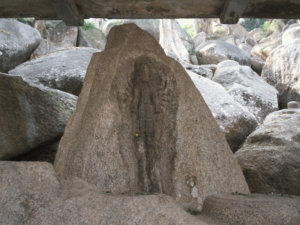
Sri Surya Pahar is located about 12 km southeast of Goalpara town is a significant but relatively unknown archaeological site in Assam, India. The site is a hilly terrain where several rock-cut Shivalingas, votive stupas and the deities of Hindu, Buddhist and Jain pantheon are scattered in an area of about one km. The site is centered on the hills (Pahar) of Sri Surya which is profusely filled up with Shiva Lingas (Lingam). The popular belief is that 99999 Shiva Lingas were engraved here by Vyasa in order to build up a second Kashi (where there were 1,00000 Shiva Lingas) and once it was one of the holiest pilgrimage sites in the region. There is no historical evidence exactly how many Lingams once dotted in these hills, but still there are hundreds of them, from tiny to large in size, scattered everywhere at the foot of the hill and covering the extensive area after centuries of neglect and pilferage. The exact figure of the Lingas (and also other deities and relics) in the hill is yet to be counted scientifically.
Another important significance of Sri Surya Pahar is that it was once a confluence of three religions as evident from the innumerable sculptures and other relics belonging to Hinduism, Buddhism and Jainism.
Remains of Hinduism
The name of ‘Sri Surya Pahar’ implies that the site was perhaps associated with the cult of sun (Surya) worship. Literary accounts corroborate that among other Hindu deities worshipped in ancient Assam, ‘Surya’ (or the Sun God) occupied a prominent place in its cultural history. References are found in the Kalika-Purana (c.10th century) about two seats of sun worship in ancient Assam. One of the centres has been identified as Sri Surya Pahar which bears the iconographic significance of the cult as well.
Some archaeologists believe that a carved stone slab, now housed in the Sri Surya Temple and worshipped as ‘Surya’, may be the detached part that formed the ceiling of the temple of Surya. The central figure in the circular carvings of the slab has been identified as Prajapati, which is carved inside an inner circle while the surrounding outer circle is in the form of twelve lotus petals. Each lotus petal has the seated figure of an Aditya. These twelve Adityas are described as twelve solar divinities namely Dhatri, Mitra, Aryaman, Rudra, Varuna, Surya, Bhaga, Vivasvan, Pushan, Savitri, Tvastri and Vishnu.
Besides the numerous stone carvings of Shiva Lingas and the ‘Prajapati’ slab, there are many rock carvings of the Hindu deities which can be seen at the foothills of Sri Surya Pahar and its adjacent areas. Notable among them are the sculptural panels of Shiva and Vishnu. The twelve-armed Vishnu with a seven-hooded canopy over its head stands prominent. It is worshipped as Dasabhuja Durga. Adorned with necklace, kundalas, armlets, garlands, etc., the deity stands erect on a lotus.
Jain Heritage
On the southern slope of Sri Surya Pahar, there is a natural cavern made of piled stones. Within the natural caves, there are Jain carvings. Remains of these Jain affiliations in the form of inscription and rock carvings are assigned to the 9th century AD. There are two figures carved in a big granite boulder which are in low relief. The figures are shown in standing posture with their hands hanging down to the knees and their cognisance are shown below the figures in low relief. Another figure carved at the top of the hill is identified as Adinath. The figure is carved in sitting posture in the rocky outcrop and two bulls are marked at the base, the mark of cognisance of the first Tirthankara. These figures are also believed to be of the 9th century AD.
Buddhist Remains
On a vast area right from the extreme north-western slope of the Sri Surya Pahar hill up to one kilometer further south, there are found as many as 25 votive stupas of different shapes and sizes cut out of granite boulders. These stupas are significant for it shows two points: firstly, there was Buddhist influence in ancient Kamarupa. It is in contrast with the commonly held belief that Buddhism was not prevalent in the cultural history of ancient Kamarupa. Secondly, the Buddhist influence in ancient Kamarupa was much earlier than in the rest of the country.
On the extreme north east corner on a higher altitude, a huge fallen granite boulder was selected for carving three giant stupas, carved in one row, facing the east. The structural feature of the stupas consists of Vedi, Medhi Anda & Harmika which are distinct. The stupas are archaic in shape with three gradually receding rings round the base. The topmost ring that supports the dome is almost semicircular in shape with flattened top. On the top of the dome there are the remnants of a square ‘harmika’ with groove in the centre to hold the shaft of ‘chhatra’ or ‘chhatravali’ (parasol). The crowning element is, however, missing. The three monolithic stupas are representative of either Dharma, Sangha & Budha or they could be termed as Uddeshika stupa carved in the memory of Lord Buddha.
Source
http://srisuryapahar.com/Photo%20Gallery.html
https://en.wikipedia.org/wiki/Sri_Surya_Pahar


